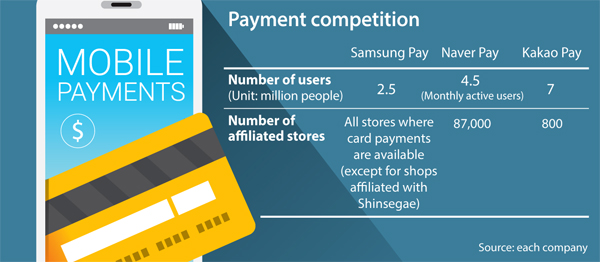3 payment giants try to differentiate services

The dominant payment service operators recently added distinctive features to their services to attract more users.
The most commonly known advantage of Samsung Pay, which has 2.5 million users in Korea, is that it works almost anywhere your credit card does if you have a Samsung Pay-enabled smartphone.
Samsung Electronics will now enable users to deposit and withdraw money from ATMs at commercial banks.
So far, only Woori Bank supports the service, but the tech giant announced last week that it is expanding its partner banks to include Shinhan Bank, KB Kookmin Bank, the Industrial Bank of Korea and NH Nonghyup Bank.
Samsung Pay is also expanding support for online shopping. Customers could use Samsung Card, KB Kookmin Card and Lotte Card for online purchases before, but NH Nonghyup Card, BC Card and Hana Card have been added.
Samsung Electronics believes its biggest appeal is the convenience of having a built-in system on your phone.
“Using the fingerprint verification system, the identification process of Samsung Pay is really simple,” said Rhee In-jong, executive vice president and head of the enterprise business at Samsung’s mobile business.
A user pays with the system by tapping twice: first to open Samsung Pay and then for a fingerprint scan.
From the point of view of stores, Samsung Pay does away with the need to install additional hardware, thanks to a piece of technology called magnetic secure transmission.
Internet portal giant Naver, operator of Naver Pay, is banking on the big user pool of the country’s largest portal site as its advantage.
Naver users don’t need to input IDs and passwords for separate online shopping malls because Naver Pay works with a single login to the site.
The operator is expanding partnerships with online shopping malls. Naver now has 75,000 affiliated e-commerce players.
A long-term goal is to set up a comprehensive shopping platform that incorporates resources on the Naver site, linking product searches and shopping with payment.
With seven million users, KakaoPay intends to boost its number of users by tapping into Kakao-affiliated platforms including KakaoTalk and Kakao Taxi.
Kakao, the operator of the payment platform, plans to launch different consumer promotions and marketing campaigns to nudge users of other Kakao platforms into paying with KakaoPay.
“We are aiming at developing KakaoPay into a payment service closely integrated with daily life and services that are necessary on a daily basis,” a source from Kakao said.
So far, both Naver and Kakao have expanded their presence online and in mobile, but users rarely choose their services for purchases in brick-and-mortar stores. To combat this, the two recently issued check cards to provide more benefits when users make payments at physical stores.
But market analysts note that excessive competition could result in narrowed margins.
BY HAN AE-RAN, PARK EUN-JEE [park.eunjee@joongang.co.kr]










with the Korea JoongAng Daily
To write comments, please log in to one of the accounts.
Standards Board Policy (0/250자)